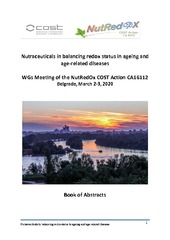Приказ основних података о документу
Inflammatory and antioxidative response of different cell lines after in vitro fructose treatment
| dc.creator | Gligorovska, Ljupka | |
| dc.creator | Ljumović, Kristina | |
| dc.creator | Ignjatović, Đurđica | |
| dc.creator | Tovilović-Kovačević, Gordana | |
| dc.creator | Đorđević, Ana | |
| dc.date.accessioned | 2020-11-18T11:05:36Z | |
| dc.date.available | 2020-11-18T11:05:36Z | |
| dc.date.issued | 2020 | |
| dc.identifier.uri | https://sites.google.com/view/costmeetingbelgrade/home | |
| dc.identifier.uri | https://radar.ibiss.bg.ac.rs/handle/123456789/3992 | |
| dc.description.abstract | Modern lifestyle, characterized by increased consumption of fructose-enriched beverages, can lead to obesity, type 2 diabetes and cardiovascular diseases. Since increased fructose intake is often associated with chronic low-grade inflammation and increased oxidative stress in various tissues, the aim was to investigate the level of inflammation and antioxidant protection in endothelial, neuroblastoma and preadipocyte cell lines treated with fructose. We examined the effects of 4-hour treatment with different concentrations of fructose (0.5 mM, 2.5 mM and 10 mM) on gene expression of pro-inflammatory cytokines (tumor necrosis factor α (TNFα), interleukin (IL) 1β and 6) in endothelial (EA.hy926), neuroblastoma (SH-SY5Y) and differentiated preadipocyte (3T3-F442A) cells. The protein levels of nuclear factor-κB (NF-κB), IκB, superoxide dismutase (SOD) 1 and 2, catalase, glutathione reductase and glutathione S-transferase, were also analyzed. In endothelial cells, 0.5 mM and 2.5 mM fructose treatment caused significant increase of TNFα mRNA level, while in SH-SY5Y and differentiated 3T3-F442A cells, IL-6 mRNA level was elevated after 0.5 mM fructose treatment. Although fructose increased pro-inflammatory cytokines in cell-type and dose-specific manner, decreased IκB protein level was detected only in adipocytes regardless of the dose. Finally, among all examined antioxidant enzymes, only SOD2 was significantly reduced in all cell types upon 2.5 mM fructose treatment. These preliminary results show that the effects of fructose on inflammation and antioxidant enzymes are both cell-type and dose specific. A marked decrease in the levels of SOD2, observed in all examined cells, can be associated with lower antioxidative defense under moderate fructose concentration. | en |
| dc.language.iso | en | sr |
| dc.publisher | University of Belgrade: Faculty of Pharmacy | sr |
| dc.relation | info:eu-repo/grantAgreement/MESTD/Integrated and Interdisciplinary Research (IIR or III)/41009/RS// | sr |
| dc.rights | openAccess | sr |
| dc.source | Nutraceuticals in balancing redox status in ageing and age-related diseases, Book of Abstracts | sr |
| dc.title | Inflammatory and antioxidative response of different cell lines after in vitro fructose treatment | en |
| dc.type | conferenceObject | sr |
| dc.rights.license | ARR | sr |
| dcterms.abstract | Глигоровска, Љупка; Товиловић Ковачевић, Гордана; Љумовић, Кристина; Игњатовић, Ђурђица; Ђорђевић, Aна; | |
| dc.rights.holder | © 2020 University of Belgrade: Faculty of Pharmacy | sr |
| dc.description.other | Nutraceuticals in balancing redox status in ageing and age-related diseases: Book of Abstracts. WGs Meeting of the NutRedOx COST Action CA16112; 2020 Mar 2-3; Belgrade, Serbia. Belgrade: Faculty of Pharmacy; 2020. p. 36. | en |
| dc.citation.vancouver | Gligorovska LjN, Ljumović KK, Ignjatović ĐS, Tovilović Kovačević GI, Djordjević AD. Inflammatory and antioxidative response of different cell lines after in vitro fructose treatment [abstract]. In: Nutraceuticals in balancing redox status in ageing and age-related diseases: Book of Abstracts. WGs Meeting of the NutRedOx COST Action CA16112; 2020 Mar 2-3; Belgrade, Serbia. Belgrade: Faculty of Pharmacy; 2020. p. 36. | |
| dc.citation.spage | 36 | |
| dc.type.version | publishedVersion | sr |
| dc.identifier.fulltext | https://radar.ibiss.bg.ac.rs/bitstream/id/7708/NutRedox-36.pdf | |
| dc.identifier.rcub | https://hdl.handle.net/21.15107/rcub_ibiss_3992 |

